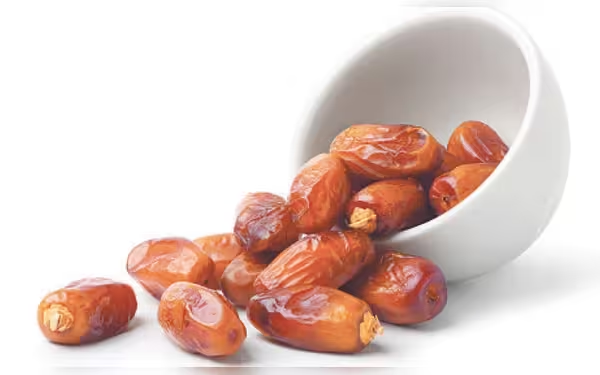Friday, October 4, 2024 02:33 PM
Challenges Facing Sindh's Date Industry
- Sindh produces 50% of Pakistan's dates.
- Post-harvest losses reach 20-30% annually.
- Modernization can enhance date product quality.
 Image Credits: dawn
Image Credits: dawnSindh's date industry faces challenges like post-harvest losses and quality inconsistency, but modernization offers significant improvement opportunities.
Pakistan stands as the fourth largest date producer globally, with an annual production estimated between 550,000 and 650,000 metric tonnes. A significant portion of this production comes from Sindh, where approximately 50 percent of the country’s dates are cultivated. The Khairpur district, in particular, is a powerhouse, contributing around 90 percent of Sindh's total date output. This makes date production a vital part of the agricultural economy in the region, supporting local consumption and generating export earnings.
Despite these advantages, the date industry in Sindh faces numerous challenges that prevent it from reaching its full potential. One of the primary issues is the lack of effective post-harvest management. After harvesting, dates must be sorted, cleaned, and graded to ensure quality and minimize losses. Unfortunately, many farmers struggle with this process, leading to significant post-harvest losses, estimated at 20-30 percent. This is particularly concerning during the monsoon season, which runs from July to September, when heavy rains can destroy up to 90 percent of the crop.
In Khairpur, traditional sun drying methods are commonly used, where dates are laid out on mats under the sun. However, this practice is not without its drawbacks. Many drying areas are not properly secured, allowing birds, insects, and other animals to contaminate the dates. As a result, the quality of the product suffers, and farmers are left with reduced marketable surplus and profitability.
Moreover, the processing facilities in Khairpur are limited and mostly small-scale, lacking advanced technology. This means that most dates are sold raw or undergo minimal processing, which does not add significant value. The absence of modern processing facilities restricts the production of high-quality products like date syrup, paste, and powder. Additionally, inadequate infrastructure, such as poor storage and inefficient transportation networks, exacerbates post-harvest losses.
Another critical issue is the inconsistency in product quality due to the lack of standardized practices in cultivation and processing. This inconsistency affects the marketability of Sindh’s dates, both locally and internationally. However, there are substantial opportunities for improvement. Investing in modern processing technologies can enhance product quality and expand the range of date-based products available in the market.
Improving infrastructure is also essential. Establishing cold storage facilities and efficient logistics can significantly reduce post-harvest losses and ensure timely access to markets. Furthermore, introducing quality certification and standardization processes can enhance the competitiveness of Sindh’s dates in international markets.
Modernizing agricultural practices is another vital strategy. By adopting high-yield date palm varieties and modern management techniques, farmers in Sindh can significantly boost their productivity. This transition requires not only access to modern farming tools but also comprehensive training programs for farmers.
Market access and development are crucial for enhancing the competitiveness of Sindh’s date products. Despite the high demand for dates, particularly in the Middle East and South Asia, the market penetration of Sindh’s dates remains limited. Developing robust marketing strategies that highlight the unique qualities of Sindh’s dates can help differentiate them in the global market.
Collaboration among government agencies, private sector companies, and international organizations is vital for improving the date palm value chain. Targeted financial solutions, such as microfinance programs offering low-interest loans, can provide much-needed capital for small producers. Additionally, forming agricultural cooperatives can enable small producers to pool resources and access larger loans, sharing expensive resources like processing equipment.
By focusing on these areas, Sindh can transform its date industry, creating diverse, high-value products that meet international standards. This transformation not only promises economic benefits but also contributes to sustainable development in the region. With the right investments and strategies, the date industry in Sindh can flourish, benefiting farmers and consumers alike.













